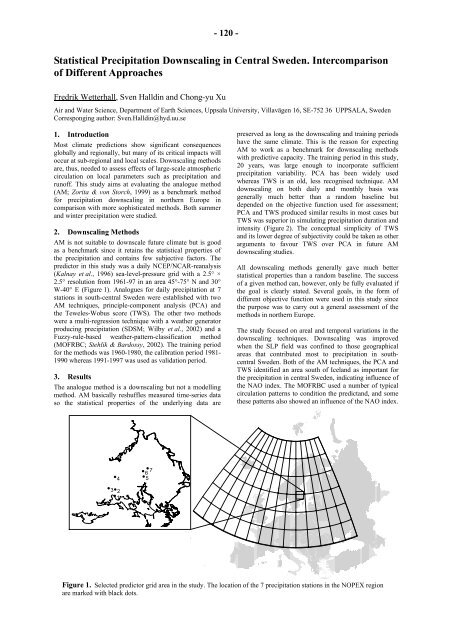Fourth Study Conference on BALTEX Scala Cinema Gudhjem
Fourth Study Conference on BALTEX Scala Cinema Gudhjem
Fourth Study Conference on BALTEX Scala Cinema Gudhjem
You also want an ePaper? Increase the reach of your titles
YUMPU automatically turns print PDFs into web optimized ePapers that Google loves.
- 120 -<br />
Statistical Precipitati<strong>on</strong> Downscaling in Central Sweden. Intercomparis<strong>on</strong><br />
of Different Approaches<br />
Fredrik Wetterhall, Sven Halldin and Ch<strong>on</strong>g-yu Xu<br />
Air and Water Science, Department of Earth Sciences, Uppsala University, Villavägen 16, SE-752 36 UPPSALA, Sweden<br />
Corresp<strong>on</strong>ging author: Sven.Halldin@hyd.uu.se<br />
1. Introducti<strong>on</strong><br />
Most climate predicti<strong>on</strong>s show significant c<strong>on</strong>sequences<br />
globally and regi<strong>on</strong>ally, but many of its critical impacts will<br />
occur at sub-regi<strong>on</strong>al and local scales. Downscaling methods<br />
are, thus, needed to assess effects of large-scale atmospheric<br />
circulati<strong>on</strong> <strong>on</strong> local parameters such as precipitati<strong>on</strong> and<br />
runoff. This study aims at evaluating the analogue method<br />
(AM; Zorita & v<strong>on</strong> Storch, 1999) as a benchmark method<br />
for precipitati<strong>on</strong> downscaling in northern Europe in<br />
comparis<strong>on</strong> with more sophisticated methods. Both summer<br />
and winter precipitati<strong>on</strong> were studied.<br />
2. Downscaling Methods<br />
AM is not suitable to downscale future climate but is good<br />
as a benchmark since it retains the statistical properties of<br />
the precipitati<strong>on</strong> and c<strong>on</strong>tains few subjective factors. The<br />
predictor in this study was a daily NCEP/NCAR-reanalysis<br />
(Kalnay et al., 1996) sea-level-pressure grid with a 2.5° ×<br />
2.5° resoluti<strong>on</strong> from 1961-97 in an area 45°-75° N and 30°<br />
W-40° E (Figure 1). Analogues for daily precipitati<strong>on</strong> at 7<br />
stati<strong>on</strong>s in south-central Sweden were established with two<br />
AM techniques, principle-comp<strong>on</strong>ent analysis (PCA) and<br />
the Teweles-Wobus score (TWS). The other two methods<br />
were a multi-regressi<strong>on</strong> technique with a weather generator<br />
producing precipitati<strong>on</strong> (SDSM; Wilby et al., 2002) and a<br />
Fuzzy-rule-based weather-pattern-classificati<strong>on</strong> method<br />
(MOFRBC; Stehlik & Bardossy, 2002). The training period<br />
for the methods was 1960-1980, the calibrati<strong>on</strong> period 1981-<br />
1990 whereas 1991-1997 was used as validati<strong>on</strong> period.<br />
3. Results<br />
The analogue method is a downscaling but not a modelling<br />
method. AM basically reshuffles measured time-series data<br />
so the statistical properties of the underlying data are<br />
5<br />
5 5<br />
5<br />
I P<br />
T U<br />
R S<br />
Q<br />
5 5<br />
5<br />
preserved as l<strong>on</strong>g as the downscaling and training periods<br />
have the same climate. This is the reas<strong>on</strong> for expecting<br />
AM to work as a benchmark for downscaling methods<br />
with predictive capacity. The training period in this study,<br />
20 years, was large enough to incorporate sufficient<br />
precipitati<strong>on</strong> variability. PCA has been widely used<br />
whereas TWS is an old, less recognised technique. AM<br />
downscaling <strong>on</strong> both daily and m<strong>on</strong>thly basis was<br />
generally much better than a random baseline but<br />
depended <strong>on</strong> the objective functi<strong>on</strong> used for assessment;<br />
PCA and TWS produced similar results in most cases but<br />
TWS was superior in simulating precipitati<strong>on</strong> durati<strong>on</strong> and<br />
intensity (Figure 2). The c<strong>on</strong>ceptual simplicity of TWS<br />
and its lower degree of subjectivity could be taken as other<br />
arguments to favour TWS over PCA in future AM<br />
downscaling studies.<br />
All downscaling methods generally gave much better<br />
statistical properties than a random baseline. The success<br />
of a given method can, however, <strong>on</strong>ly be fully evaluated if<br />
the goal is clearly stated. Several goals, in the form of<br />
different objective functi<strong>on</strong> were used in this study since<br />
the purpose was to carry out a general assessment of the<br />
methods in northern Europe.<br />
The study focused <strong>on</strong> areal and temporal variati<strong>on</strong>s in the<br />
downscaling techniques. Downscaling was improved<br />
when the SLP field was c<strong>on</strong>fined to those geographical<br />
areas that c<strong>on</strong>tributed most to precipitati<strong>on</strong> in southcentral<br />
Sweden. Both of the AM techniques, the PCA and<br />
TWS identified an area south of Iceland as important for<br />
the precipitati<strong>on</strong> in central Sweden, indicating influence of<br />
the NAO index. The MOFRBC used a number of typical<br />
circulati<strong>on</strong> patterns to c<strong>on</strong>diti<strong>on</strong> the predictand, and some<br />
these patterns also showed an influence of the NAO index.<br />
Figure 1. Selected predictor grid area in the study. The locati<strong>on</strong> of the 7 precipitati<strong>on</strong> stati<strong>on</strong>s in the NOPEX regi<strong>on</strong><br />
are marked with black dots.













